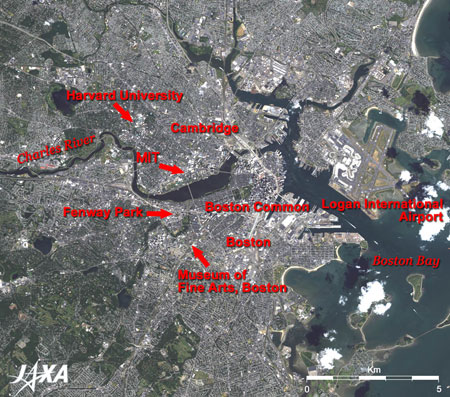Seen from Space 2007
Boston, Birthplace of USA and Cambridge, City of Universities
Islands in the Boston Bay are fringed with white sandy beaches, the natural charms of which might have attracted pilgrims who had come to the New World across the Atlantic Ocean. Cambridge, named after the academic city in London, is located on the north side of the Charles River. Many bright students from all over the world come to this town. Harvard University has produced many leaders of every sector of society including politicians such as the late president Kennedy, and Massachusetts Institute of Technology (MIT) has produced a number of Nobel Prize scholars. Harvard University, established in 1636, is the oldest university in the United States. The campus is located where the Charles River winds to the north, and blue-roofed school buildings are visible in its center. There is another campus in Boston on the opposite bank of the Charles River where the Harvard Football Stadium can be seen. The MIT campus is located in a green square along the Charles River, where the large Kresge Auditorium with a blue roof and a football stadium with the red stands are visible. Cambridge is the sister city of Tsukuba Science City in Japan. Boston is located in the south of the Charles River. Boston is the oldest city on the east coast of the United States and was founded by immigrant colonists from England in the 17th century. A red (mostly brick) path through downtown Boston known as the "Freedom Trail" leads tourists to significant historical sites. It is a 4 km walk from the Boston Common in the center of the city. The green area adjacent to the Boston Common is the Public Garden, the first botanical garden in the United States. The orderly blocked town along the river, starting from the garden is the Back Bay district where Victorian style brownstone houses remain. The forest of the Back Bay Fens spreads across the west end of this district. The Museum of Fine Arts, Boston, which boasts a large collection of oriental art including Ukiyoe, is located beside the forest. In the south of the downtown, one of the three ships where the "Boston Tea Party" took place on Thursday, December 16, 1773, is restored and moored on the canal. The incident has been seen as helping to spark the American Revolution. The vivid red ground visible between the Back Bay Fens forest and the Charles River is Fenway Park, the home ballpark of the Boston Red Sox, where legendary baseball player Babe Ruth once played. In the spring of 2007, Daisuke Matsuzaka, who represents Japanese baseball, is expected to pitch on the mound beside the art museum that collected the essence of Japanese culture and to play an active part.
|





